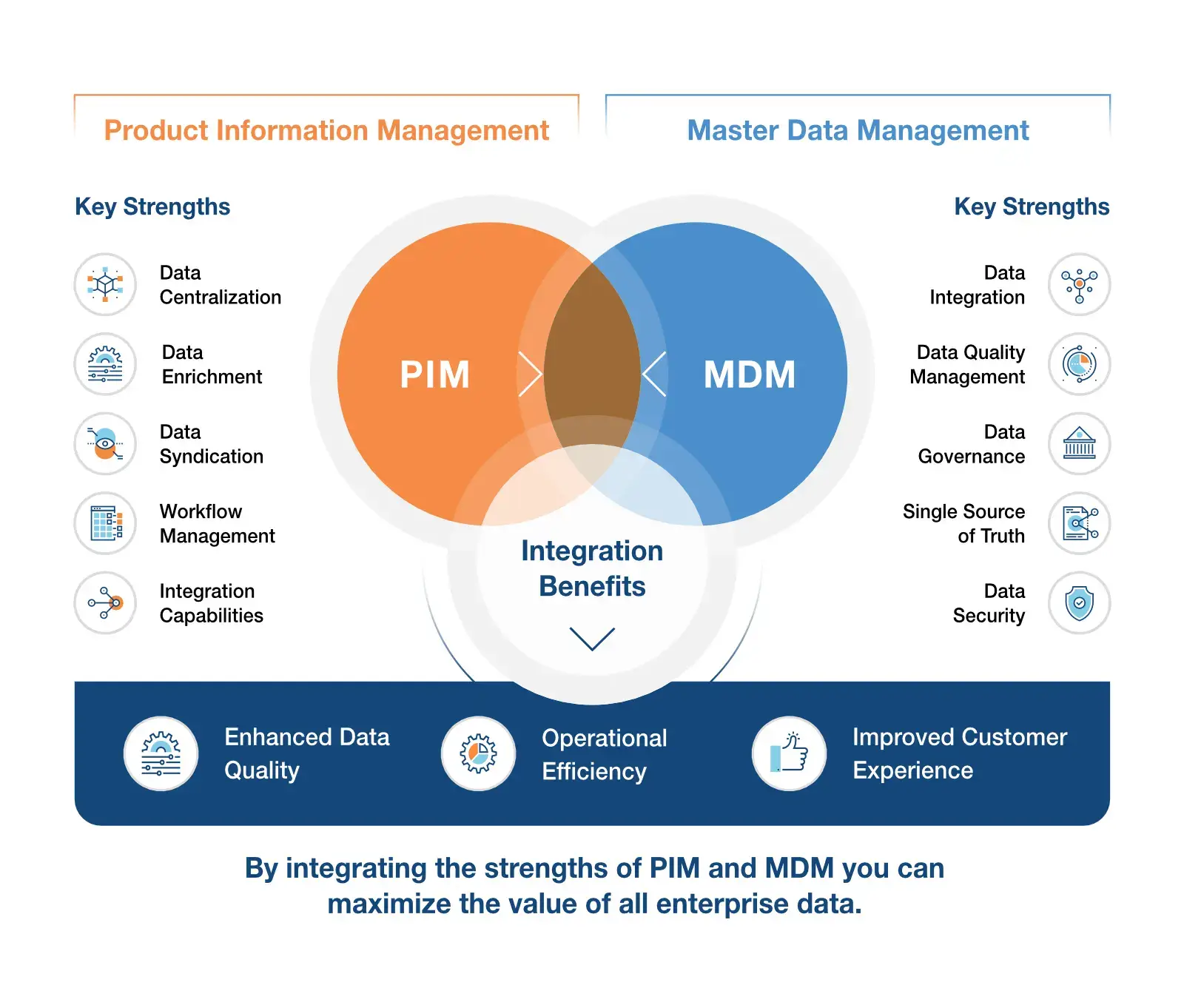Welcome to our comprehensive guide on Product Information Management (PIM) and Master Data Management (MDM). In today’s data-driven business environment, understanding the distinctions between these two systems is crucial for effective data management and operational efficiency.
Both PIM and MDM play vital roles in managing enterprise data. However, their purposes, functionalities, and benefits differ significantly. Without a clear understanding of these differences, businesses may struggle with inefficient data utilization, poor data quality, and lower profitability.
This guide will provide a detailed comparison of PIM and MDM, helping you make informed decisions about which system is best suited for your business needs. By the end of this guide, you’ll have a solid grasp of how PIM and MDM can drive business success through improved decision-making, optimized processes, and strategic data leverage.
PIM vs MDM: Table of Contents
What is PIM?
Product Information Management (PIM) is a system designed to centralize and manage product information for businesses. It acts as a single source of truth for all product-related data, ensuring that information is accurate, consistent, and up-to-date across all sales channels and customer touchpoints. PIM is particularly beneficial for organizations that manage a large volume of product data, have complex product catalogs, or operate across multiple sales channels. It serves a vital function within companies projected to grow at a CAGR of 25.5% from 2020 to 2027.
Key Functions of PIM
- Data Centralization: PIM systems centralize all product information, making it easily accessible and manageable from a single platform.
- Data Enrichment: Enhance product data with additional attributes, descriptions, and multimedia content to provide a richer customer experience.
- Data Syndication: Distribute product information to various sales channels, marketplaces, and partners, ensuring consistency across all platforms.
- Workflow Management: Streamline the process of updating and approving product data, with role-based access and version control.
- Integration Capabilities: Seamlessly integrate with other business systems such as ERP, CRM, and eCommerce platforms to ensure data consistency across the organization.
Benefits of PIM
- Improved Data Quality: Centralizing and standardizing product information reduces errors and inconsistencies, leading to higher data quality.
- Operational Efficiency: Automating the management and distribution of product information saves time and resources, allowing teams to focus on more strategic tasks.
- Enhanced Customer Experience: Providing accurate and detailed product information improves the customer buying experience, leading to higher satisfaction and loyalty.
- Faster Time-to-Market: Streamlined processes and efficient data management enable quicker product launches and updates.
- Scalability: PIM systems can handle large volumes of product data, making it easier for businesses to scale their operations and expand into new markets.
PIM Use Case Examples
- Retail: A large retailer uses a PIM system to manage thousands of product SKUs, ensuring that accurate and consistent information is available across all online and offline sales channels.
- Manufacturing: A manufacturer leverages PIM to centralize product specifications, manuals, and marketing materials, streamlining communication with distributors and customers.
- eCommerce: An eCommerce company uses PIM to enrich product descriptions with high-quality images and detailed specifications, enhancing the online shopping experience.
What is MDM?
Master Data Management (MDM) is a comprehensive method used to define and manage the critical data of an organization to provide a single point of reference. MDM ensures the consistency, accuracy, and accountability of an organization’s shared master data assets. The primary purpose of MDM is to streamline data sharing among personnel and departments, ensuring that the entire organization operates on the same set of reliable data. Maintaining data integrity is critical for today’s leading companies.
Key Functions of MDM
- Data Integration: MDM integrates data from various sources, consolidating it into a single, consistent dataset. Consequently, this unified approach enhances data accessibility and usability across the organization.
- Data Quality Management: By implementing processes and tools to maintain high-quality data, MDM cleanses, standardizes, and de-duplicates records. Therefore, organizations benefit from more reliable and accurate data.
- Data Governance: MDM establishes policies, procedures, and standards for data management, ensuring compliance and accountability. As a result, organizations can maintain regulatory adherence and data integrity.
- Single Source of Truth: MDM provides a unified view of master data, ensuring that all departments and systems use consistent information. Hence, this consistency supports better decision-making and operational efficiency.
- Data Security: By implementing security measures to protect sensitive data, MDM ensures that only authorized users have access. Consequently, this approach safeguards data privacy and integrity.
Benefits of MDM
- Improved Decision-Making: With accurate and consistent data, organizations can make better-informed decisions. Consequently, this leads to more strategic planning and execution.
- Operational Efficiency: By reducing the time and resources required to manage and reconcile data across different systems, organizations achieve greater efficiency. As a result, they can focus on core activities.
- Enhanced Data Quality: Ensuring that data is accurate, complete, and up-to-date reduces errors and inconsistencies. Therefore, organizations can trust their data for critical operations.
- Regulatory Compliance: By maintaining accurate and auditable records, organizations can comply with data-related regulations more effectively. This, in turn, helps avoid legal issues and fines.
- Cost Savings: Reducing costs associated with data errors, duplication, and inefficiencies leads to significant savings. Hence, organizations can allocate resources more effectively.
MDM Use Case Examples
- Healthcare: A hospital system uses MDM to maintain accurate patient records, ensuring that all departments have access to the same information, improving patient care and operational efficiency.
- Finance: A financial institution leverages MDM to manage customer data across various branches and services, ensuring consistency and accuracy in financial reporting and customer interactions.
- Supply Chain: A global manufacturer uses MDM to manage supplier and product data, streamlining operations and improving supply chain efficiency.
Comparing PIM and MDM

Core Differences
Scope and Focus:
- PIM (Product Information Management): Focuses on managing and enriching product-related information. It is primarily used to centralize, organize, and distribute product data across various sales channels.
- MDM (Master Data Management): Encompasses a broader scope, managing critical master data for an organization, which includes not only product information but also customer, supplier, and employee data.
Purpose:
- PIM: Designed to enhance the quality and consistency of product data, ensuring that all product information is accurate, complete, and up-to-date across all platforms.
- MDM: Aims to provide a single source of truth for all critical data, ensuring that all departments and systems within an organization use consistent and reliable information.
Data Types:
- PIM: Deals specifically with product-related data, such as descriptions, specifications, images, and pricing.
- MDM: Manages a wide range of data types, including product data, customer data, supplier data, and more.
Use Cases:
- PIM: Ideal for businesses with extensive product catalogs and complex sales channels that require consistent and enriched product information.
- MDM: Suitable for organizations that need to manage multiple types of master data across various departments and systems to ensure data integrity and consistency.
When to Use PIM vs. MDM
Use PIM:
-
- You should use PIM when your primary focus is on managing product information.
- Additionally, PIM is essential if you need to enhance the quality and consistency of product data across multiple sales channels.
- Finally, PIM is highly beneficial when you require a system to centralize and distribute product information efficiently.
Use MDM:
-
- MDM is essential when managing multiple critical data types beyond product information.
- Furthermore, MDM is necessary if your organization requires a unified view of master data across different departments and systems.
- Additionally, MDM is crucial when data governance, quality management, and regulatory compliance are important.
Integration of PIM and MDM
Integrating PIM and MDM can provide comprehensive data management solutions, combining the strengths of both systems. Here are the benefits and challenges of integration:Benefits
- Enhanced Data Quality: By combining PIM’s detailed product information with MDM’s broader data management capabilities, organizations ensure high data quality and consistency across the board. Consequently, this integration enhances the reliability of data used in various operations.
- Operational Efficiency: Streamlined processes and unified data management lead to more efficient operations and better decision-making. Therefore, organizations can optimize their workflows and improve overall productivity.
- Improved Customer Experience: Accurate, enriched product information combined with customer data enhances the overall customer experience.
Challenges
- Complex Integration: Integrating PIM and MDM systems can be complex and requires careful planning and execution.
- Data Synchronization: Ensuring that data is synchronized between PIM and MDM systems can be challenging, particularly in real-time scenarios.
- Resource Allocation: Implementing and maintaining integrated systems requires significant resources, including time, budget, and skilled personnel.
Implementation Strategies
Choosing the Right System
Selecting the appropriate system for your organization depends on your specific business needs and objectives. Here are some tips to help you choose between PIM and MDM:
- Assess Your Data Needs: Determine whether your primary focus is on product information or if you need to manage a broader range of master data.
- Identify Key Use Cases: Consider the main use cases for each system. PIM is ideal for managing product data across multiple sales channels, while MDM is better suited for ensuring data consistency and governance across various departments.
- Evaluate Integration Requirements: If you require integration with other business systems (e.g., ERP, CRM), assess which solution offers better integration capabilities so your systems can work together efficiently.
- Consider Scalability: Choose a system that can scale with your business as your data management needs grow because you do not want your business to run into roadblocks as it grows.
- Consult Stakeholders: Involve key stakeholders from different departments to understand their data requirements because this will ensure the chosen system meets their needs.
Best Practices for Implementation
Implementing PIM or MDM requires careful planning and execution. Follow these best practices to ensure a successful implementation:
- Define Clear Objectives: Establish clear goals and objectives for the implementation so you have a guide and a way to measure the process’ success.
- Develop a Data Governance Framework: Create a framework that outlines data ownership, policies, and procedures to ensure data quality and compliance.
- Conduct a Data Audit: Perform a thorough audit of your existing data so you can identify inconsistencies, duplicates, and gaps that need to be addressed.
- Select the Right Technology: Choose a PIM or MDM solution that aligns with your business requirements and integrates seamlessly with your existing systems so you may maximize efficiency.
- Engage Stakeholders: Involve key stakeholders throughout the implementation process to ensure their needs are met and gain their buy-in so you may avoid setbacks and confusion.
- Provide Training: Train your team on the new system to ensure they understand how to use it effectively and maintain data quality.
- Monitor and Optimize: Continuously monitor the system’s performance and make necessary adjustments to optimize data management processes so your organization reaps the full benefits and ROI from the implementation.
Common Pitfalls and How to Avoid Them
Avoiding common pitfalls can help ensure a smooth and successful implementation. Here are some potential challenges and strategies to overcome them:
- Lack of Clear Objectives: Without clear objectives, the implementation process can become unfocused. Define specific goals and success metrics from the outset so your likelihood of success is increased.
- Insufficient Data Governance: Poor data governance can lead to data inconsistencies and compliance issues. Establish a robust governance framework to maintain data quality and accountability.
- Resistance to Change: Employees may resist adopting new systems. Address this by involving them in the process, providing training, and communicating the benefits of the new system so that employee buy-in is realized.
- Underestimating Complexity: Implementing PIM or MDM can be complex. Plan thoroughly, allocate sufficient resources, and seek expert guidance if needed so your organization does not waste precious time and resources.
- Inadequate Integration: Ensure the chosen system integrates well with your existing business systems to avoid data silos and inefficiencies.
- Neglecting Continuous Improvement: Data management needs evolve over time. Regularly review and optimize your PIM or MDM system to keep it aligned with your business goals so your organization is never out of step.
Case Studies
Successful PIM Implementations
Retail Giant’s Enhanced Customer Experience
- Company: A leading global retail chain
- Challenge: Managing a vast product catalog with inconsistent and outdated product information across various sales channels.
- Solution: Implemented a PIM system to centralize and standardize product information.
- Outcome: Improved data accuracy and consistency across all sales channels, resulting in enhanced customer experience, reduced product returns, and increased sales.
eCommerce Platform’s Streamlined Product Management
- Company: A rapidly growing eCommerce company
- Challenge: Handling an extensive and diverse range of product data while ensuring high-quality product information for customers.
- Solution: Deployed a PIM system to manage and enrich product data, including detailed descriptions, high-quality images, and accurate specifications.
- Outcome: Streamlined product management processes, faster product launches, and a significant boost in customer satisfaction and conversion rates.
Successful MDM Implementations
Healthcare Network’s Improved Patient Data Management
- Company: A large regional healthcare network
- Challenge: Inconsistent and fragmented patient data across multiple departments and facilities.
- Solution: Implemented an MDM solution to integrate and manage patient data from various sources.
- Outcome: Achieved a single, unified view of patient data, leading to improved patient care, streamlined operations, and enhanced regulatory compliance.
Financial Institution’s Data Governance Excellence
- Company: A major financial institution
- Challenge: Managing and maintaining consistent customer data across different branches and service lines.
- Solution: Introduced an MDM system to standardize customer data and implement data governance policies.
- Outcome: Enhanced data quality, reduced data duplication, and improved customer service and operational efficiency.
Combined PIM and MDM Success Stories
Global Manufacturer’s Unified Data Strategy
- Company: A multinational manufacturing company
- Challenge: Managing product and supplier data across various regions and business units, leading to data silos and inefficiencies.
- Solution: Integrated PIM and MDM systems to manage product information and master data holistically.
- Outcome: Achieved a single source of truth for both product and supplier data, resulting in streamlined operations, improved data quality, and better decision-making.
Retailer’s Comprehensive Data Management
- Company: A large online and brick-and-mortar retailer
- Challenge: Ensuring consistent and high-quality product and customer data across multiple platforms and touchpoints.
- Solution: Deployed both PIM and MDM systems to manage product and customer data effectively.
- Outcome: Enhanced data consistency and accuracy, leading to better customer experiences, optimized marketing efforts, and increased sales.
Future Trends
The Future of PIM and MDM
- Increased Integration with AI and Machine Learning:
- Trend: The integration of Artificial Intelligence (AI) and Machine Learning (ML) with PIM and MDM systems is expected to grow.
- Impact: AI and ML can enhance data management capabilities by automating data cleansing, enriching product information, and predicting trends. These technologies are important because they can help organizations achieve higher data accuracy, efficiency, and deeper insights.
- Focus on Real-Time Data Management:
- Trend: There is a growing emphasis on real-time data management within PIM and MDM solutions.
- Impact: Real-time data management allows businesses to make quicker and more informed decisions. It is a growing trend because it enhances operational efficiency and ensures that all stakeholders have access to the most up-to-date information.
- Expansion of IoT Data Integration:
- Trend: The Internet of Things (IoT) is generating massive amounts of data, and its integration with PIM and MDM systems is on the rise.
- Impact: By incorporating IoT data, organizations can improve product management, supply chain operations, and customer insights. This integration is on our radar because it supports more accurate and dynamic data management strategies.
- Enhanced Data Security and Privacy Measures:
- Trend: As data privacy regulations become stricter, PIM and MDM systems are incorporating advanced security features.
- Impact: Enhanced security measures, such as data encryption, access controls, and compliance management, help organizations protect sensitive data and adhere to regulatory requirements.
- Greater Emphasis on Customer Experience:
- Trend: PIM and MDM systems are increasingly focusing on improving the customer experience.
- Impact: By providing accurate and consistent product and customer data, businesses can offer personalized and seamless experiences. This focus helps in building customer loyalty and driving sales.
Innovations to Watch
- Graph Databases:
- Innovation: Graph databases are becoming popular for managing complex relationships between data entities.
- Impact: They offer a more flexible and efficient way to store and query interconnected data, which is beneficial for both PIM and MDM systems in handling intricate data relationships.
- Blockchain for Data Integrity:
- Innovation: Blockchain technology is being explored to ensure data integrity and traceability.
- Impact: Blockchain can provide a secure and immutable ledger for tracking changes to data, enhancing transparency and trust in PIM and MDM systems.
- Augmented Reality (AR) and Virtual Reality (VR):
- Innovation: AR and VR technologies are being integrated with PIM systems to enhance product visualization and customer engagement.
- Impact: These technologies allow customers to interact with products in a virtual environment, improving the shopping experience and aiding in more informed purchase decisions.
- Data Fabric Architecture:
- Innovation: Data fabric architecture is an emerging approach to manage data across a distributed landscape.
- Impact: It provides a unified data management framework, making it easier to access, integrate, and manage data across multiple platforms and environments, benefiting both PIM and MDM implementations.
FAQs
PIM focuses on managing product-related information, while MDM manages a broader range of master data, including product, customer, supplier, and employee data.
Yes, integrating PIM and MDM can provide comprehensive data management solutions, enhancing data quality, operational efficiency, and decision-making.
Businesses with extensive product catalogs, complex sales channels, and a need for consistent and enriched product information benefit the most from PIM.
MDM ensures data consistency, improves decision-making, enhances operational efficiency, and helps with regulatory compliance.
Assess your data management needs, identify key use cases, evaluate integration requirements, consider scalability, and consult stakeholders to choose the right system.
Conclusion
Throughout this guide, we have explored the crucial roles that Product Information Management (PIM) and Master Data Management (MDM) play in modern business environments. Here are the key takeaways:
- Understanding PIM and MDM: PIM focuses on managing product-related information, ensuring accuracy and consistency across all sales channels. MDM, on the other hand, provides a single source of truth for all critical master data, including product, customer, supplier, and employee information.
- Core Differences: PIM and MDM serve different purposes and data types. Understanding this difference is important. While PIM is ideal for businesses with extensive product catalogs, MDM is suited for organizations needing comprehensive data governance across various departments.
- Benefits: Both PIM and MDM offer significant benefits, including improved data quality, operational efficiency, enhanced customer experience, better decision-making, and compliance with regulatory standards.
- Implementation Strategies: Successful implementation of PIM and MDM involves clear objectives, robust data governance, stakeholder engagement, and continuous optimization.
- Case Studies: Real-world examples, therefore, demonstrate how organizations have leveraged PIM and MDM to achieve operational excellence and data-driven success.
- Future Trends: The future of PIM and MDM is being shaped by advancements in AI, real-time data management, IoT integration, enhanced security measures, and innovations such as graph databases and blockchain because these technologies are revolutionizing data management and producing better outcomes. Therefore, staying updated with these advancements is crucial for businesses aiming to remain competitive.
Infoverity Can Transform Your Data Management Strategy
Whether you’re looking to implement product information management, master data management, improve data quality, streamline operations, or achieve a 360-degree view of your customers, Infoverity has the expertise and solutions to make your goals a reality. Our team of experts specializes in tailoring CRM and MDM integration strategies that align with your unique business needs. Infoverity ensures you overcome the common pitfalls of integration and maximize the return on your investment. Contact us to schedule your consultation today.
Bonus Checklist: PIM and MDM Implementation
Use this checklist because you don’t want to miss a single detail. You’ll ensure you’ve considered every important aspect at every step of your PIM and MDM implementation journey.
Pre-Implementation Checklist
- Assess Your Data Management Needs
-
-
- ☐ Identify key data types and sources.
- ☐ Determine the primary focus (product data vs. master data).
-
- Define Clear Objectives
-
-
- ☐ Set specific, measurable goals for the implementation.
- ☐ Establish success metrics to track progress.
-
- Develop a Data Governance Framework
-
-
- ☐ Outline data ownership roles and responsibilities.
- ☐ Create data policies and standards.
- ☐ Ensure compliance with regulatory requirements.
-
- Conduct a Data Audit
-
-
- ☐ Identify data inconsistencies, duplicates, and gaps.
- ☐ Cleanse and standardize existing data.
-
Implementation Checklist
- Select the Right Technology
-
-
- ☐ Evaluate PIM and MDM solutions based on your needs.
- ☐ Ensure compatibility with existing systems (ERP, CRM, etc.).
-
- Engage Stakeholders
-
-
- ☐ Involve key stakeholders from relevant departments.
- ☐ Communicate the benefits and gather feedback.
-
- Plan Integration
-
-
- ☐ Develop an integration strategy for seamless data flow.
- ☐ Ensure real-time data synchronization where necessary.
-
- Provide Training
-
-
- ☐ Conduct training sessions for all users.
- ☐ Develop user manuals and support materials.
-
- Implement in Phases
-
-
- ☐ Start with a pilot program to test the system.
- ☐ Gradually roll out the system across the organization.
-
Post-Implementation Checklist
- Monitor Performance
-
-
- ☐ Track the performance of the PIM or MDM system.
- ☐ Use success metrics to evaluate effectiveness.
-
- Optimize Continuously
-
-
- ☐ Regularly review and refine data management processes.
- ☐ Address any issues promptly and make necessary adjustments.
-
- Maintain Data Quality
-
-
- ☐ Implement ongoing data quality checks.
- ☐ Ensure data governance policies are followed.
-
- Stay Updated
-
-
- ☐ Keep up with the latest trends and innovations in data management.
- ☐ Upgrade the system as needed to leverage new technologies.
-
- Gather Feedback
-
-
- ☐ Collect feedback from users to identify areas for improvement.
- ☐ Make iterative changes based on feedback.
-



